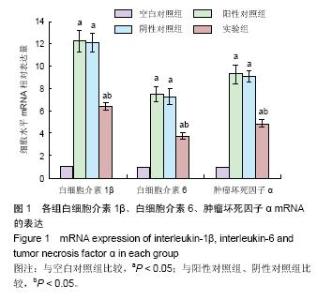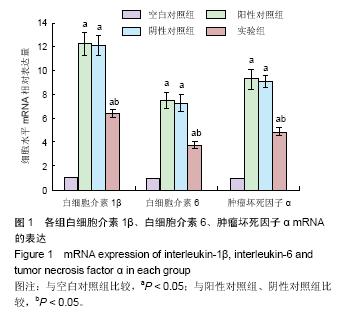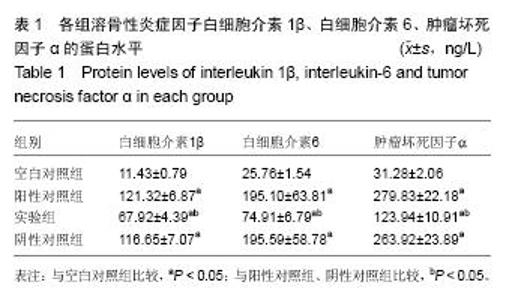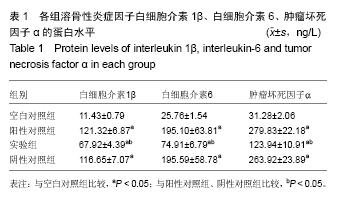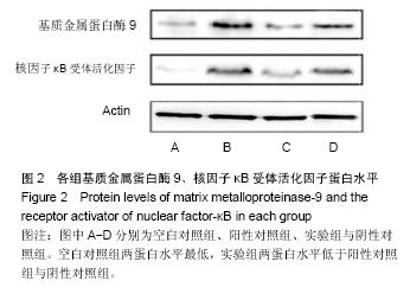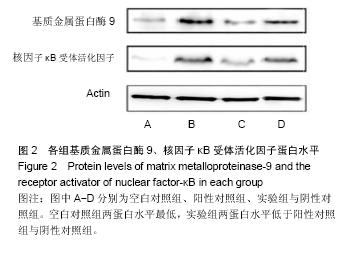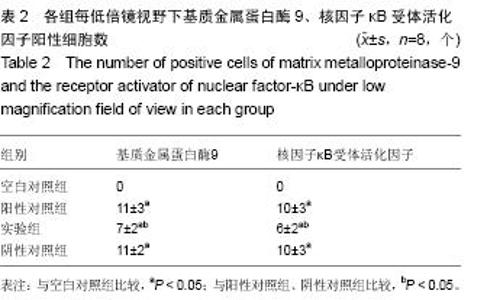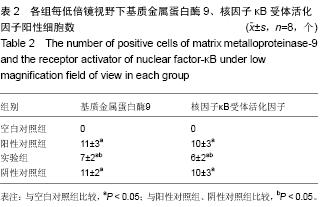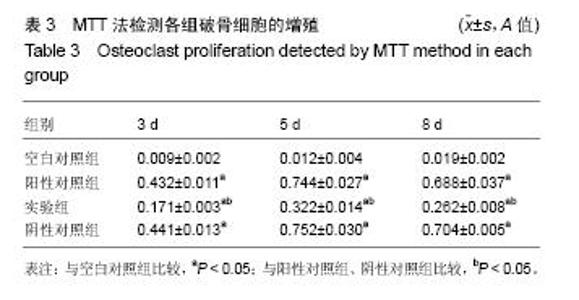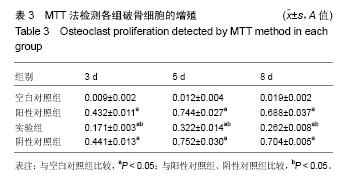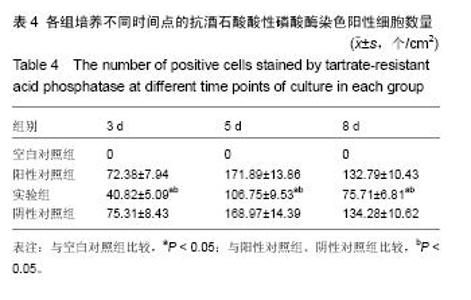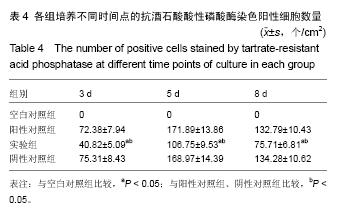Chinese Journal of Tissue Engineering Research ›› 2015, Vol. 19 ›› Issue (52): 8384-8390.doi: 10.3969/j.issn.2095-4344.2015.52.004
Previous Articles Next Articles
Inhibitory effect of Sema7A siRNA on osteoclast activation induced by titanium particles
Cong Yu, Ru Jiang-ying, Zhao Yun-long, Yu Lei, Bao Ni-rong, Xu Bin, Zhao Jian-ning
- Department of Orthopedics, Nanjing General Hospital of Nanjing Military Region of Chinese PLA (Nanjing Clinical Medical School Affiliated to the Second Military Medical University of Chinese PLA), Nanjing 210002, Jiangsu Province, China
-
Received:2015-11-04Online:2015-12-17Published:2015-12-17 -
Contact:Zhao Jian-ning, Professor, Doctoral supervisor, Department of Orthopedics, Nanjing General Hospital of Nanjing Military Region of Chinese PLA (Nanjing Clinical Medical School Affiliated to the Second Military Medical University of Chinese PLA), Nanjing 210002, Jiangsu Province, China -
About author:Cong Yu, Studying for doctorate, Department of Orthopedics, Nanjing General Hospital of Nanjing Military Region of Chinese PLA (Nanjing Clinical Medical School Affiliated to the Second Military Medical University of Chinese PLA), Nanjing 210002, Jiangsu Province, China -
Supported by:Nanjing Military Medical Scientific Research Program of China, No. 14MS112; the Clinical Medicine Science and Technology Program of Jiangsu Province, China, No. BL2012002
CLC Number:
Cite this article
Cong Yu, Ru Jiang-ying, Zhao Yun-long, Yu Lei, Bao Ni-rong, Xu Bin, Zhao Jian-ning. Inhibitory effect of Sema7A siRNA on osteoclast activation induced by titanium particles[J]. Chinese Journal of Tissue Engineering Research, 2015, 19(52): 8384-8390.
share this article
| [1] Kurtz S,Ong K,Lau E,et al.Projections of primary and revision hip and knee arthroplasty in the United States from 2005 to 2030.J Bone Joint Surg Am.2007; 89(4):780-785. [2] Deirmengian GK,Zmistowski B,O'Neil JT,et al.Management of acetabular bone loss in revision total hip arthroplasty.J Bone Joint Surg Am.2011;93(19):1842-1852. [3] Garcia-Cimbrelo E,Garcia-Rey E,Cruz-Pardos A.The extent of the bone defect affects the outcome of femoral reconstruction in revision surgery with impacted bone grafting: a five- to 17-year follow-up study.J Bone Joint Surg Br.2011; 93(11):1457-1464. [4] Cordova LA,Stresing V,Gobin B,et al.Orthopaedic implant failure: aseptic implant loosening--the contribution and future challenges of mouse models in translational research.Clin Sci (Lond).2014;127(5):277-293. [5] Sabokbar A,Kudo O,Athanasou NA.Two distinct cellular mechanisms of osteoclast formation and bone resorption in periprosthetic osteolysis.J Orthop Res.2003; 21(1):73-80. [6] Gallo J,Slouf M,Goodman SB.The relationship of polyethylene wear to particle size, distribution, and number:A possible factor explaining the risk of osteolysis after hip arthroplasty.J Biomed Mater Res B Appl Biomater.2010;94(1): 171-177. [7] Atkins GJ,Haynes DR,Howie DW,et al.Role of polyethylene particles in peri-prosthetic osteolysis: A review.World J Orthop. 2011;2(10):93-101. [8] Konttinen YT,Pajarinen J.Adverse reactions to metal-on-metal implants.Nat Rev Rheumatol.2013;9(1):5-6. [9] Hartmann A,Hannemann F,Lutzner J,et al.Metal ion concentrations in body fluids after implantation of hip replacements with metal-on-metal bearing--systematic review of clinical and epidemiological studies.PLOS ONE.2013; 8(8): e70359. [10] Langton DJ,Sidaginamale RP,Joyce TJ,et al.The clinical implications of elevated blood metal ion concentrations in asymptomatic patients with MoM hip resurfacings: a cohort study.BMJ Open.2013;3(5):e001541corr1. [11] Jongbloets BC,Ramakers GM,Pasterkamp RJ.Semaphorin7A and its receptors: pleiotropic regulators of immune cell function, bone homeostasis, and neural development.Semin Cell Dev Biol.2013;24(3):129-138. [12] Holmes S,Downs AM,Fosberry A,et al.Sema7A is a potent monocyte stimulator. Scand J Immunol.2002;56(3):270-275. [13] Delorme G,Saltel F,Bonnelye E,et al.Expression and function of semaphorin 7A in bone cells.Biol Cell.2005;97(7):589-597. [14] Solarino G,Piazzolla A,Notarnicola A,et al.Long-term results of 32-mm alumina-on-alumina THA for avascular necrosis of the femoral head.J Orthop Traumatol. 2012;13(1): 21-27. [15] Ulrich SD,Seyler TM,Bennett D,et al.Total hip arthroplasties: what are the reasons for revision.Int Orthop.2008;32(5): 597-604. [16] Nathan C,Ding A.Nonresolving inflammation. Cell.2010; 140(6):871-882. [17] Cooper HJ, Ranawat AS, Potter HG,et al.Early reactive synovitis and osteolysis after total hip arthroplasty. Clin Orthop Relat Res.2010;468(12):3278-3285. [18] Maloney W,Rosenberg A.What is the outcome of treatment for osteolysis. J Am Acad Orthop Surg.2008;16 Suppl 1: S26-32. [19] Harris WH.Conquest of a worldwide human disease: particle-induced periprosthetic osteolysis.Clin Orthop Relat Res.2004;(429):39-42. [20] Ren PG,Irani A,Huang Z,et al.Continuous infusion of UHMWPE particles induces increased bone macrophages and osteolysis.Clin Orthop Relat Res.2011;469(1):113-122. [21] Gallo J,Goodman SB,Konttinen YT,et al.Particle disease: biologic mechanisms of periprosthetic osteolysis in total hip arthroplasty.Innate Immun.2013;19(2):213-224. [22] Zlotnik A,Burkhardt AM,Homey B.Homeostatic chemokine receptors and organ-specific metastasis. Nat Rev Immunol. 2011;11(9):597-606. [23] Goodman SB,Ma T.Cellular chemotaxis induced by wear particles from joint replacements.Biomaterials. 2010;31(19): 5045-5050. [24] Catelas I,Jacobs JJ.Biologic activity of wear particles.Instr Course Lect. 2010;59:3-16. [25] Choi MG,Koh HS,Kluess D,et al.Effects of titanium particle size on osteoblast functions in vitro and in vivo.Proc Natl Acad Sci U S A.2005;102(12):4578-4583. [26] Takei H,Pioletti DP,Kwon SY,et al.Combined effect of titanium particles and TNF-alpha on the production of IL-6 by osteoblast-like cells.J Biomed Mater Res. 2000; 52 (2):382-387. [27] Kolodkin AL,Matthes DJ,Goodman CS.The semaphorin genes encode a family of transmembrane and secreted growth cone guidance molecules.Cell.1993;75(7):1389-1399. |
| [1] | Chen Ziyang, Pu Rui, Deng Shuang, Yuan Lingyan. Regulatory effect of exosomes on exercise-mediated insulin resistance diseases [J]. Chinese Journal of Tissue Engineering Research, 2021, 25(25): 4089-4094. |
| [2] | Chen Yang, Huang Denggao, Gao Yuanhui, Wang Shunlan, Cao Hui, Zheng Linlin, He Haowei, Luo Siqin, Xiao Jingchuan, Zhang Yingai, Zhang Shufang. Low-intensity pulsed ultrasound promotes the proliferation and adhesion of human adipose-derived mesenchymal stem cells [J]. Chinese Journal of Tissue Engineering Research, 2021, 25(25): 3949-3955. |
| [3] | Yang Junhui, Luo Jinli, Yuan Xiaoping. Effects of human growth hormone on proliferation and osteogenic differentiation of human periodontal ligament stem cells [J]. Chinese Journal of Tissue Engineering Research, 2021, 25(25): 3956-3961. |
| [4] | Sun Jianwei, Yang Xinming, Zhang Ying. Effect of montelukast combined with bone marrow mesenchymal stem cell transplantation on spinal cord injury in rat models [J]. Chinese Journal of Tissue Engineering Research, 2021, 25(25): 3962-3969. |
| [5] | Gao Shan, Huang Dongjing, Hong Haiman, Jia Jingqiao, Meng Fei. Comparison on the curative effect of human placenta-derived mesenchymal stem cells and induced islet-like cells in gestational diabetes mellitus rats [J]. Chinese Journal of Tissue Engineering Research, 2021, 25(25): 3981-3987. |
| [6] | Hao Xiaona, Zhang Yingjie, Li Yuyun, Xu Tao. Bone marrow mesenchymal stem cells overexpressing prolyl oligopeptidase on the repair of liver fibrosis in rat models [J]. Chinese Journal of Tissue Engineering Research, 2021, 25(25): 3988-3993. |
| [7] | Liu Jianyou, Jia Zhongwei, Niu Jiawei, Cao Xinjie, Zhang Dong, Wei Jie. A new method for measuring the anteversion angle of the femoral neck by constructing the three-dimensional digital model of the femur [J]. Chinese Journal of Tissue Engineering Research, 2021, 25(24): 3779-3783. |
| [8] | Meng Lingjie, Qian Hui, Sheng Xiaolei, Lu Jianfeng, Huang Jianping, Qi Liangang, Liu Zongbao. Application of three-dimensional printing technology combined with bone cement in minimally invasive treatment of the collapsed Sanders III type of calcaneal fractures [J]. Chinese Journal of Tissue Engineering Research, 2021, 25(24): 3784-3789. |
| [9] | Qian Xuankun, Huang Hefei, Wu Chengcong, Liu Keting, Ou Hua, Zhang Jinpeng, Ren Jing, Wan Jianshan. Computer-assisted navigation combined with minimally invasive transforaminal lumbar interbody fusion for lumbar spondylolisthesis [J]. Chinese Journal of Tissue Engineering Research, 2021, 25(24): 3790-3795. |
| [10] | Hu Jing, Xiang Yang, Ye Chuan, Han Ziji. Three-dimensional printing assisted screw placement and freehand pedicle screw fixation in the treatment of thoracolumbar fractures: 1-year follow-up [J]. Chinese Journal of Tissue Engineering Research, 2021, 25(24): 3804-3809. |
| [11] | Shu Qihang, Liao Yijia, Xue Jingbo, Yan Yiguo, Wang Cheng. Three-dimensional finite element analysis of a new three-dimensional printed porous fusion cage for cervical vertebra [J]. Chinese Journal of Tissue Engineering Research, 2021, 25(24): 3810-3815. |
| [12] | Wang Yihan, Li Yang, Zhang Ling, Zhang Rui, Xu Ruida, Han Xiaofeng, Cheng Guangqi, Wang Weil. Application of three-dimensional visualization technology for digital orthopedics in the reduction and fixation of intertrochanteric fracture [J]. Chinese Journal of Tissue Engineering Research, 2021, 25(24): 3816-3820. |
| [13] | Sun Maji, Wang Qiuan, Zhang Xingchen, Guo Chong, Yuan Feng, Guo Kaijin. Development and biomechanical analysis of a new anterior cervical pedicle screw fixation system [J]. Chinese Journal of Tissue Engineering Research, 2021, 25(24): 3821-3825. |
| [14] | Lin Wang, Wang Yingying, Guo Weizhong, Yuan Cuihua, Xu Shenggui, Zhang Shenshen, Lin Chengshou. Adopting expanded lateral approach to enhance the mechanical stability and knee function for treating posterolateral column fracture of tibial plateau [J]. Chinese Journal of Tissue Engineering Research, 2021, 25(24): 3826-3827. |
| [15] | Zhu Yun, Chen Yu, Qiu Hao, Liu Dun, Jin Guorong, Chen Shimou, Weng Zheng. Finite element analysis for treatment of osteoporotic femoral fracture with far cortical locking screw [J]. Chinese Journal of Tissue Engineering Research, 2021, 25(24): 3832-3837. |
| Viewed | ||||||
|
Full text |
|
|||||
|
Abstract |
|
|||||
